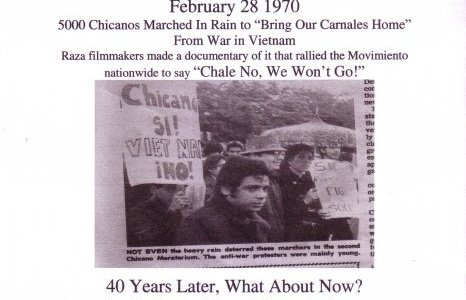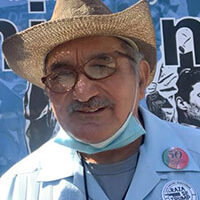
People familiar with the term “Chicano Moratorium,” identify it with the date of August 29, 1970, when some 30,000 Chicanos and progressives marched through East Los Angeles against the Vietnam War. Most also identify it with the fatal “mistake” shooting of journalist Ruben Salazar by a county sheriff who was ostensibly quelling a riot.
The August 29 1970 Chicano Moratorium is an event that all the people of the United States should know about, but don’t. Most histories pay little attention to Mexican Americans and ignore events like the moratorium. When it is mentioned the focus is on Salazar’s death or rioting by angry demonstrators, but not on the sheriff’s attack, and even less on why so many marched that day, which was the disproportionate burden and social costs of the unjust war on Chicanos/Mexican Americans.
To get a better idea about why and how Chicanos organized their own peace demonstrations during the Vietnam War it is important to understand the moratorium as part of a movement, a cause that developed consciously and grew over time. The main reason August 29, 1970, national moratorium was so large was because over 20 other smaller moratoriums had taken place beforehand. The most critical of those was held February 28, 1970, also in East Los Angeles.
In my opinion February 28 was a decisive turning point in the Chicano antiwar movement. It rained relentlessly that day, over 2 inches, I believe, yet 5,000 Chicanos turned out and kept on marching to Laguna Park, which truly was a laguna (lake) that day. Hundreds if not thousands of shoppers on the parade route stopped, watched and cheered the passing marchers despite the downpour.
It was the first Chicano demonstrations when a Chicana organization, Las Adelitas de Aztlan, marched in its own right,. Many units of the Brown Berets marched having come from Santa Barbara, Riverside, Oakland and San Diego. College MEChA groups marched with their banners.
It could have been larger without the rain, but not more dramatic. The Chicano movement was mobilizing its communities en masse against the unjust Vietnam war where Chicanos were dying at twice the rate of others! The burning words of the grassroots leaders speaking at the rally were not doused by the rain. They carried more meaning and conviction because of it.
Perhaps just as important is that the dramatic march, the on-looking crowd and inspiring rally were filmed and professionally developed into a people’s documentary that truly made history. The moratorium had 20 copies made that were shown hundreds and hundreds of times in barrio after barrio across the United States. When the film was shown to 2,000 Chicano youth leaders at the Second Chicano Liberation Conference on March 28, 1970, at the Crusade for Justice in Denver, they overwhelmingly voted to support a National Chicano Moratorium on August 29, 1970, in East Los Angeles with smaller local moratoriums across the country organized to build for the national one. Some Chicanos who opposed the war in part felt that peace moratoriums were a white middle class “thing,” however the film dramatically showed that Chicano moratoriums could be full of Chicano Power adding to all the people’s power for peace.
You can see this film this Sunday, February 28 at 2p.m. at Salazar Park Hall 3864 Whittier Blvd (East) Los Angeles 90023. The film showing will be followed by a panel discussion of leaders of the 1970 march in the rain and activists of today. It’s all about peace! The event is sponsored by the 40th Anniversary Commemoration Committee of the Chicano Moratoriums, email chicano.moratorium@gmail.com, tel. 323-229-1994.










